The Traveler… seeking Governor Wilson… the cats meow…
January 9, 2012 by The Traveler · Leave a Comment
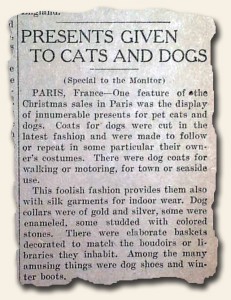 Today I traveled to January 9, 1912. While reading The Christian Science Monitor, Boston, Massachusetts I discovered that not unlike many in 2012, scores of citizens were also looking for the right man to run in opposition of the President in the upcoming presidential election. The headline read “Democrats Turn To Gov. Wilson As Man to Defeat Mr. Taft”, with the subheads, “Decide They Must Nominate Radical to Oppose president, as Conservative, and Thus Avert a Third Party”, “Find Him Popular” and “National Committeemen Surprised to Discover Sentiment Among Rank and File for New Jersey Candidate”. It is interesting to see history playing out many of the same themes over time.
Today I traveled to January 9, 1912. While reading The Christian Science Monitor, Boston, Massachusetts I discovered that not unlike many in 2012, scores of citizens were also looking for the right man to run in opposition of the President in the upcoming presidential election. The headline read “Democrats Turn To Gov. Wilson As Man to Defeat Mr. Taft”, with the subheads, “Decide They Must Nominate Radical to Oppose president, as Conservative, and Thus Avert a Third Party”, “Find Him Popular” and “National Committeemen Surprised to Discover Sentiment Among Rank and File for New Jersey Candidate”. It is interesting to see history playing out many of the same themes over time.
I realize that Christmas has passed, but a small article on “Presents Given To Cats and Dogs” caught my eye. I know that pampering of four-legged friends is very trendy now, but I did not know that it was “cats meow” then as well!
~The Traveler
The Civil War… 150 years ago… January 4, 1862…
January 4, 2012 by GuyHeilenman · Leave a Comment
We continue our weekly series of reflections on the Civil War with a new twist for 2012. Each week we will provide access to descriptions and images of newspapers (and occasionally other periodicals) printed exactly 150 years ago… to-date. While many are no longer available for sale, reading a snap-shot of what was printed for the given day will hopefully provide a glimpse of life during the critical period in American history. Each link shown will take you to the full description w/ images of authentic issues which were held by those living during the Civil War. Today’s selections are:
 HARPER’S WEEKLY, January 4, 1862 Full front page by Homer: “Christmas Boxes in Camp, 1861” does show some mild wear, as this was the first page in the volume. Fullpg. with 3 scenes of “Ship Island”. Fullpg: “Bird’s-eye View of the Coast from Savannah, Ga. to Beaufort, S.C.” Nice dblpgctrfld. is a large: “General Bird’s-Eye View of Washington & Vicinity”. Small print of: “Green River Bridge, Kentucky” & a fullpg. with 2 scenes of: “Gen. Burnside’s Expedition” showing many ships. This issue also contains “Charles Dickens’ New Christmas Stories – 1. Picking Up Evening Shadows, and 2. Picking Up A Pocket-Book”, by Charles Dickens, taking nearly 5 entire pages of text.
HARPER’S WEEKLY, January 4, 1862 Full front page by Homer: “Christmas Boxes in Camp, 1861” does show some mild wear, as this was the first page in the volume. Fullpg. with 3 scenes of “Ship Island”. Fullpg: “Bird’s-eye View of the Coast from Savannah, Ga. to Beaufort, S.C.” Nice dblpgctrfld. is a large: “General Bird’s-Eye View of Washington & Vicinity”. Small print of: “Green River Bridge, Kentucky” & a fullpg. with 2 scenes of: “Gen. Burnside’s Expedition” showing many ships. This issue also contains “Charles Dickens’ New Christmas Stories – 1. Picking Up Evening Shadows, and 2. Picking Up A Pocket-Book”, by Charles Dickens, taking nearly 5 entire pages of text.
BOSTON EVENING TRANSCRIPT, Boston, MA, January 4, 1862 * Fort Pickens Florida FL – Prestonburg, Kentucky… and much more. This 4 page newspaper is in nice condition due to the use of cotton and rag paper during this very historic time in U.S. history.
The Traveler… promise to pay…
December 19, 2011 by The Traveler · Leave a Comment
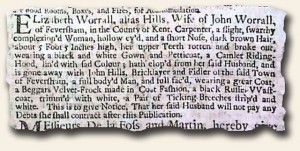 Today I found myself in London, England with the Post-Boy dated December 20, 1711. I also found that even with traveling back three hundred years, a portion of this paper would fit right into today’s newsstands. An article on the front page of this issue was the reporting “…to Bribe an honest member of the Church of England, to vote against the interest of that church, and his own conscience…”. The text of the “promise to pay” note is included in the article as well.
Today I found myself in London, England with the Post-Boy dated December 20, 1711. I also found that even with traveling back three hundred years, a portion of this paper would fit right into today’s newsstands. An article on the front page of this issue was the reporting “…to Bribe an honest member of the Church of England, to vote against the interest of that church, and his own conscience…”. The text of the “promise to pay” note is included in the article as well.
On the back page of this issue also contains a notice posted by a husband, stating that he would no longer be responsible for his wife’s debts. The description of his wife is very interesting!!
Until next year, I wish you all a very Merry Christmas and a Happy New Year!
~The Traveler
“Nursery Rhymes” on the Civil War…
November 12, 2011 by TimHughes · Leave a Comment
Parody songs are not uncommon on the airwaves today, particularly around Christmas time. Apparently adapting words to fit an existing tune–or poem–is nothing new as this May 17, 1865 issue of “The Springfield Daily Republican” shows (see below). These were certainly not the high-water mark of the varied Union responses to the end of the war: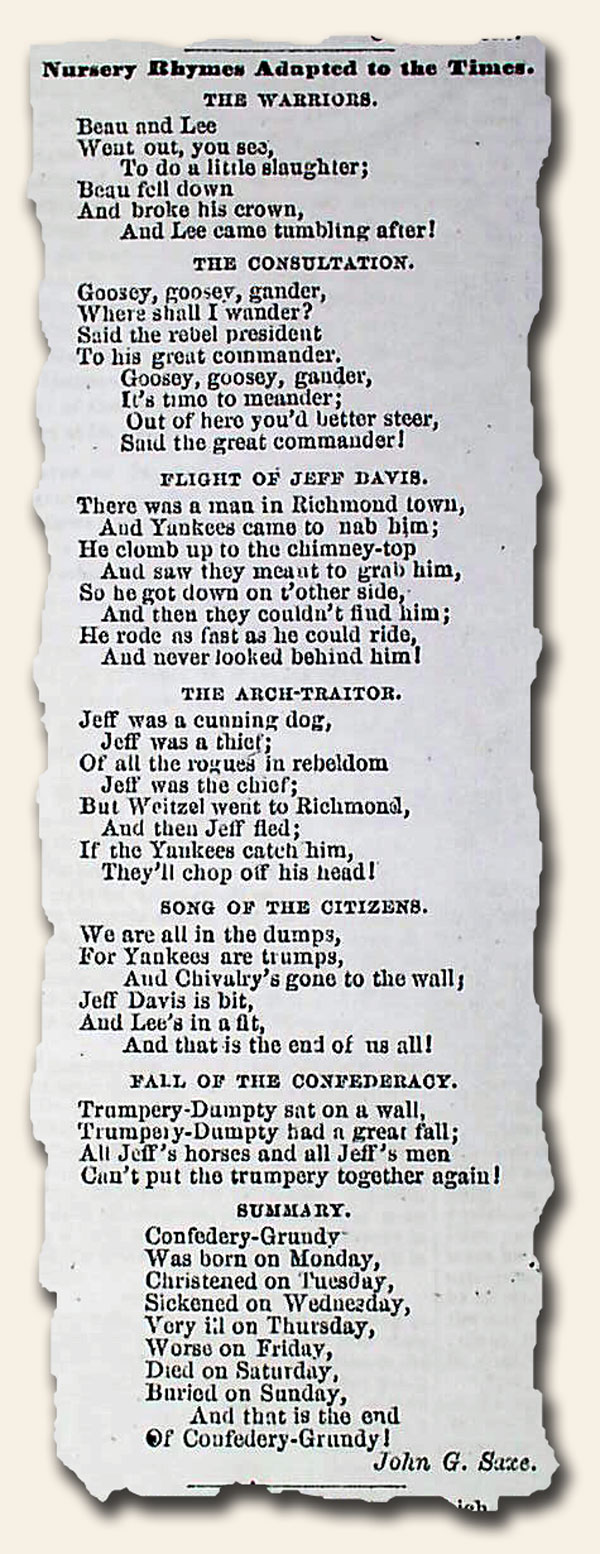
A few holiday thoughts…
December 22, 2010 by GuyHeilenman · Leave a Comment
Dear Friends of Rare & Early Newspapers,
While the holiday season is a time of celebration and joy for most, it is also a time of sadness and depression for others – as they reflect on the loss of loved ones, their own difficult  circumstances, and/or the troubles of friends and relatives. A few years ago, on the heals of the “Great Fall” of 2008, we posted a few thoughts on life. As we glide, saunter, and/or stumble (for some) through the holiday season, please enjoy reflections on this past post:
circumstances, and/or the troubles of friends and relatives. A few years ago, on the heals of the “Great Fall” of 2008, we posted a few thoughts on life. As we glide, saunter, and/or stumble (for some) through the holiday season, please enjoy reflections on this past post:
“This too shall pass” (Hebrew: גם זה יעבור, gam zeh yaavor) is a phrase occurring in a Jewish wisdom folktale involving King Solomon. The phrase is commonly engraved on silver rings.
Many versions of the folktale have been recorded by the Israel Folklore Archive at the University of Haifa. Heda Jason recorded this version told by David Franko from Turkey:
“One day Solomon decided to humble Benaiah Ben Yehoyada, his most trusted minister. He said to him, “Benaiah, there is a certain ring that I want you to bring to me. I wish to wear it for Sukkot which gives you six months to find it.” “If it exists anywhere on earth, your majesty,” replied Benaiah, “I will find it and bring it to you, but what makes the ring so special?” “It has magic powers,” answered the king. “If a happy man looks at it, he becomes sad, and if a sad man looks at it, he becomes happy.” Solomon knew that no such ring existed in the world, but he wished to give his minister a little taste of humility. Spring passed and then summer, and still Benaiah had no idea where he could find the ring. On the night before Sukkot, he decided to take a walk in one of the poorest quarters of Jerusalem. He passed by a merchant who had begun to set out the day’s wares on a shabby carpet. “Have you by any chance heard of a magic ring that makes the happy wearer forget his joy and the broken-hearted wearer forget his sorrows?” asked Benaiah. He watched the grandfather take a plain gold ring from his carpet and engrave something on it. When Benaiah read the words on the ring, his face broke out in a wide smile. That night the entire city welcomed in the holiday of Sukkot with great festivity. “Well, my friend,” said Solomon, “have you found what I sent you after?” All the ministers laughed and Solomon himself smiled. To everyone’s surprise, Benaiah held up a small gold ring and declared, “Here it is, your majesty!” As soon as Solomon read the inscription, the smile vanished from his face. The jeweler had written three Hebrew letters on the gold band: gimel, zayin, yud, which began the words “Gam zeh ya’avor” — “This too shall pass.” At that moment Solomon realized that all his wisdom and fabulous wealth and tremendous power were but fleeting things, for one day he would be nothing but dust.”
The phrase “This too shall pass” and the associated ring story were made popular by Abraham Lincoln in his ‘Address Before the Wisconsin State Agricultural Society, Milwaukee, Wisconsin’ on September 30, 1859.
“It is said an Eastern monarch once charged his wise men to invent him a sentence, to be ever in view, and which should be true and appropriate in all times and situations. They presented him the words: “And this, too, shall pass away.” How much it expresses! How chastening in the hour of pride! How consoling in the depths of affliction!
As we look back on the previous 2+ years, we see much has occurred since this posting. While we’ve lost loved ones, lost faithful collector friends, and observed many succumb to the realities of the economy, we’ve also enjoyed the strength that comes from weathering shared troubles, the joy of meeting new friends, and the quiet confidence that comes from seeing God’s hand in action in an endless number of circumstances. It is times of difficulty which encourage us to value the important things in life and to grasp the reality of “This Too Shall Pass” as we endeavor to store up treasures in heaven where moth and rust do not destroy. Please know that YOU, our dear friends, are such treasures. Thank you for your ongoing friendships.
Merry Christmas (and Happy Hanukkah to our Jewish family),
Your Friends at Timothy Hughes Rare & Early Newspapers
(Guy, Tim, Doreen, Brian, Mike, Gerry, Hannah, Sarah, Rebekah, Joshua…)
Timothy Hughes Rare & Early Newspapers . . .
. . . History’s Newsstand
“…desiring to conduct ourselves honorably in all things.” Hebrews 13:18b
20th century prices realized… revisted…
September 30, 2010 by GuyHeilenman · 2 Comments
The previous post focused on “prices realized” from a sampling of key issues from the 20th century. Fellow collector, Charles Signer, posted a response we thought collectors would appreciate.
These papers (see previous post) are excellent choices for your article. I think the Titanic disaster marked a new era in journalism, since improvements in printing technology and inventions like the facsimile machine made it possible for newspapers all over the United States and the world for the first time to cover the story simultaneously with full coverage and great graphics. Because the Titanic event took place at sea there was no “home advantage” as there would have been for a disaster taking place in a populated area. I don’t have the Rhode Island version of the story that you show, but I have seen others like it from other cities. I am amazed how they could get such good reporting and graphics literally overnight on such an unexpected story.
When I see the Honolulu Star-Bulletin First Extra I think of it as a time capsule marking of an end of an era. The front page of course gives the full first report, but the inside pages were mostly set up before the event, in the last hours of peacetime. The ads for 1941 consumer goods and Christmas sales suddenly fell out of place in the grim new wartime world. I imagine the people shown in the ads floating at the bottom of the ocean where they are all drowned dead but still visible to divers. It’s eerie.
I was going to say that the whole First Extra paper could be seen on the Honolulu Star-Bulletin website, but in trying to test the link as I write this I see that the Honolulu Star-Bulletin and the Honolulu Advertiser merged on June 7, 2010. The combined paper is now the Honolulu Star-Advertiser. There used to be a great story on the Star-Bulletin’s old website about the people who put out those first reports that day. I guess it’s gone now.
I got a copy of the Dewey Defeats Truman paper from Tim Hughes before 2000 for about $850. It was real cherry. I grew up in Chicago where my dad and I would drive down in the evenings to get the first edition of the following day’s Tribune. When you opened up a Tribune for the first time there were tiny holes made in the printing process which made the pages stick together. The copy I got from Tim had those little holes so I knew I was opening that Dewey Defeats Truman paper for the first time ever. It was almost like being there on November 2, 1948, the evening the paper was printed. Yes, it truly is a classic that will be recognized as long as newspapers are remembered, which may be a lot longer than some of them are being published.
Thanks Charles!
How times have changed…
February 6, 2010 by TimHughes · Leave a Comment
In recent years, particularly near the Christmas holiday, there are many reports of organizations soliciting drives for various needs for soldiers overseas, often including toiletry items, nonperishable foods, bottled water, and other needed staples.
Such drives were common in World War II as well. Note the report in the “Beacon” newspaper from the Philadelphia Navy Yard, Oct. 1, 1943. I doubt today there would be a “Smokes for Buddies” rally to send two million cigarettes to our soldiers overseas.
Walmart sells them too…
December 12, 2009 by TimHughes · Leave a Comment
A 1685 issue of the “London Gazette” newspaper contains on the back page the following interesting advertisement, not the type typically found in newspapers–at least not in more modern times. Interesting that the coffin maker notes that he makes them: “…of a sort of wood that will endure until the body is fully dissolved…”.
I saw a piece recently where Walmart now sells coffins on-line. And just in time for Christmas:
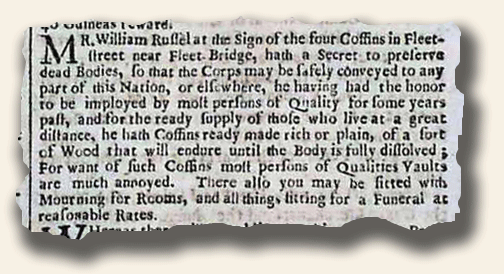
Related collectibles… carrier & newsie memorabilia…
October 8, 2009 by TimHughes · 1 Comment
The world of rare newspaper collecting need not be limited to just newspapers. I’ve ventured into peripheral collectibles which I find interesting, and I’m wondering if any of you have as well.
 I’ve picked up several “paper bags” as we used to call them, and which are rarely seen today. They are the cloth “slings” newspaper carriers wore over the shoulder in which newspapers we held when being delivered (does anyone remember them?).
I’ve picked up several “paper bags” as we used to call them, and which are rarely seen today. They are the cloth “slings” newspaper carriers wore over the shoulder in which newspapers we held when being delivered (does anyone remember them?).
I’ve also purchased two of the newspaper wagons used in the earlier part of the 20th century in which carriers pulled the day’s edition as he made his deliver rounds. They make decorative pieces today and look much like other early children’s wagons but often had higher side rails. And they were distinguished by the newspaper name & logo painted on the sides.
I’ve also collecting little nick-knack figurines which include a newspaper in some way, and my, have I been amazed how many exist! There is at least one Hummel piece, a few Precious Moments, and a number of more “generic” brand figurines which feature a newspaper in a variety of ways. And those who collect Christmas pieces will encounter numerous miniature print shops and newsstands if they browse in any mall gift or specialty shop. I’ve also found a few framed prints which show someone reading a newspaper, or perhaps a newspaper print shop, a news carrier, etc.
What related newspaper collectibles do you pursue? Feel free to respond and share with others.
The “Carrier’s Address”…
August 27, 2009 by TimHughes · Leave a Comment
Credit for portions of the following must be given to Clarence Brigham & his work “Journals & Journeymen”, as well as to the Bentley Historical Library at the University of Michigan.
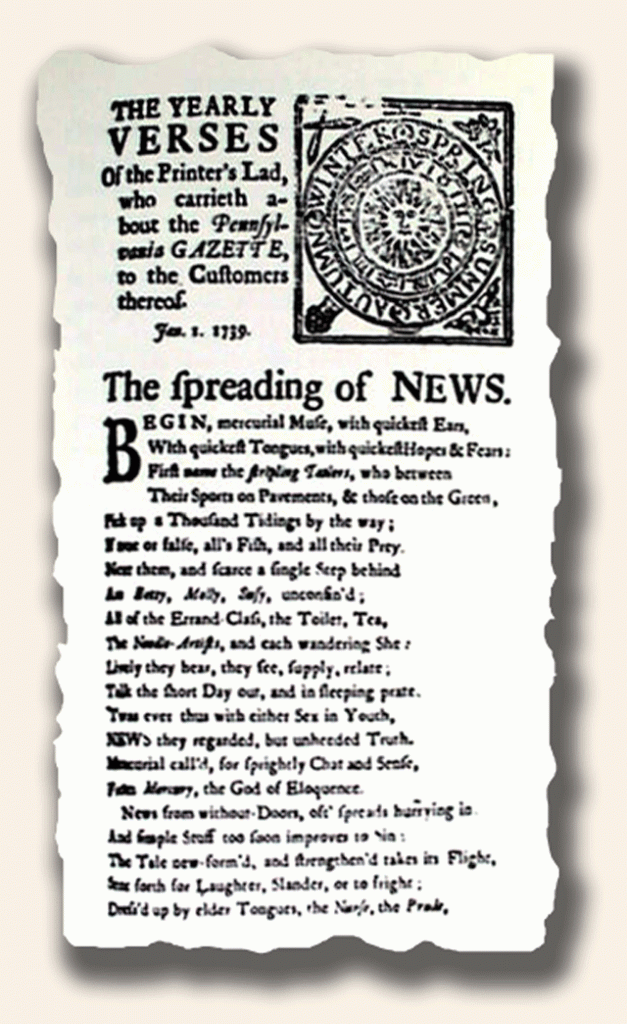 During the nineteenth century, newspaper carriers were often not paid by the publishers of the papers. They typically depended upon donations from patrons at the end of the year. To remind the public that the carriers depended on their donations, newspaper publishers issued poetic broadsides or booklets for New Years Day. These poems often recounted the major news stories of the previous year, but always closed with a plea to pay the carrier.
During the nineteenth century, newspaper carriers were often not paid by the publishers of the papers. They typically depended upon donations from patrons at the end of the year. To remind the public that the carriers depended on their donations, newspaper publishers issued poetic broadsides or booklets for New Years Day. These poems often recounted the major news stories of the previous year, but always closed with a plea to pay the carrier.
They were rarely saved since they contained no news reports and as a result are rather rare today. Although many Carriers’ Addresses were contained within the body of the first newspaper issue in the new year, the most sought after are the broadside editions, printed on one side of a sheet of paper typically with ornate lettering, decorative borders, etc. The more decorative the Address the more collectible. The “New York Weekly Museum” address for 1790 had an engraving of a boy delivering a paper at a doorway, one of just a few with such an illustration.
The earliest known examples were done for the “American Weekly Mercury” of Philadelphia in 1720, 1721 and 1723 although none have been found. The earliest located for the American Antiquarian Society is that of January 1, 1735. Benjamin Franklin included them in his “Pennsylvania Gazette” as early as 1739 (see photo).
The amount of the donation expected by the carrier was generally left to the customer. Many of the verses concluded with such a sentiment as “Remember the poor printer’s Devil” or “Be bounteous to the Printer’s boy”. Sometimes the sentiment was more definite, such as “I won’t Refuse a six pence” and “Please keep the cents and–give the silver”.
By the 1870’s the custom began to fall off, likely due to the beginning of more commercial & larger influential newspapers which considered such a custom undignified, also falling away in favor of the distribution of Christmas or New Year’s cards by the end of the 19th century. The latest located for the American Antiquarian Society is dated 1904.


